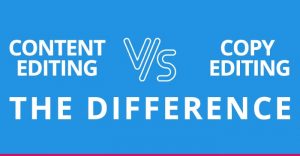
Have you ever been given a task to proofread a document and confused it with editing? If yes, do not worry, it often tends to happen to the best of us. These two words are sometimes used interchangeably but have very different meanings.
However, they both may work individually or simultaneously to bring about the same results – improving a piece of writing and making it as easy to read as possible. As you read further on, in this article you will find answers regarding these two terminologies and a clear explanation of the difference between editing and proofreading.
Editing
Literary and language experts claim that the difference between editing and proofreading is that editing is an art while proofreading is a science, and we agree. Editing helps ensure that the overall quality of the said piece of writing is improved. While proofreading does not make major changes in the text, editing may bring about major changes. Always ask yourself the following questions to know the extent to which your piece needs to be edited.
- Did you use passive voice to write your piece?
- Does your article have lengthy sentences and/or unnecessarily repetitive words?
- Is your article written in the appropriate tone, according to the context?
- Does your article contain the appropriate vocabulary to convey your message?
- Could you have used a better persuasive tone to address your argument?
Editing is on a deeper level relative to proofreading. It works in a way to make sure the final product of your writing is comprehensive amongst its audience. Editing requires a close assessment of the content to figure out what is lacking and adjust it accordingly.
Only professionals who have experience in editing pieces of all sorts can know an unusual tone, or the lack thereof, in one read. Their knowledge does not just limit to clarifying text by correcting spelling, grammar, and the general sentence structure, but may also extend to double-checking facts and statistics in some cases. The following is usually categorized under the job of an editor:
- The modifying tone for impact and consistency
- Managing layout and graphic inserts in the content
- Checking for genuineness and validity of facts and statistics mentioned
- Improving content quality
- Ensuring a proper word flow
- Clarifying language and ideas
If for some reason, you don’t want to hire an editor and are inclined towards doing the editing work yourself after writing, we suggest setting your content work aside for at least two days after finishing it. By revisiting your text after days, you will be starting with a fresh mind and will more likely be able to see parts that need editing more clearly.
Proofreading
The difference between proofreading and editing lies mainly amongst their types and methods. Unlike editing, this does not take as much creativity. It is, however, an important step to attaining a writing masterpiece. Proofreading focuses mainly on surface errors and does certainly not go as deep as editing. The surface errors could be as simple as spellings, punctuation, and grammar blunders or a little complex as maintaining consistency of tone, formatting throughout, and perfecting the writing. Although it looks like proofreading is not a demanding job, the proofreader is also expected to be professionally qualified and skilled to identify the tiny errors, which are otherwise ignored by a casual reader.
The tasks commonly performed by a proofreader include:
- Checking that all links in a piece of content are functional
- Checking for grammar and spelling mistakes
- Checking for plagiarism
- Verifying that the content writing adheres to the appropriate style guide
- Fixing improper word choices
This proves one of the core differences between editing and proofreading; the proofreader has a much narrower set of tasks, all on the superficial level. Only those who understand the nuances of the English language are qualified to be proofreaders.
The following four types of proofreading practices are available in the market:
1. Academic Proofreading
Academic proofreading includes proofreading the work of students, researchers, and professors in the field of academics. Often researchers and professors need a quick solution to oversee their pieces of writing and proofread last-minute citations, endnotes, footnotes, quotations, and reference lists. With the privilege of hiring academic proofreaders, their content can be properly formatted as per the required style guide.
Academic articles to be published in journals, college applications, essays, personal statements, dissertations, research papers, and statements of purpose benefit a great deal from this type of proofreading. However, in some fields of academia, getting one’s work proofread may be a prohibition, or worse, illegal. These fields may include English literature courses, ESL, etc.
2. Business Proofreading
This includes proofreading the content that is written by business owners or is related to a particular business in any regard. They may involve user manuals, reports, emails, newsletters, press releases, grant proposals, resumes, and blog posts.
Customers are likely to not take your business seriously if your articles have a fair amount of spelling and grammatical errors. Hence, to offer guaranteed products, it is essential for business retailers and owners to ensure that their marketing blogs are published after being thoroughly proofread.
Business proofreading is not just restricted to catering to a group of business dealers. It may also include hiring a second pair of eyes for a job seeker. This type of proofreading not only improves business writing but may also help someone seal their job position by fixing superficial errors in their resume.
3. Print Media Proofreading
Commonly revolving around proper formatting; print media proofreading works best for self-publishing authors or publishers. Typeset documents are technically proofread with a hard copy or PDF. Either way, when those working in the print media department proofread the said document, it may be printed as books and e-books, directories, greeting cards, magazines, newspapers, screenplays, etc.
Flagging widows (the short final line of a paragraph that spontaneously appears at the top of the next page), designing appropriate margins, word breaks, and correct page number sequences, ensuring consistent formatting, and double-checking table of contents, indexes, and appendixes are also categorized under the roles of a print media proofreader.
4. Translation Proofreading
This type of proofreading gives us a more vivid idea of the differences between proofreading and copy editing. This type of proofreading involves proofreading a document that has been translated from one language to another. One of the most common examples of this could be translating a document from a google translator or any online service provider and getting sentences that seem a bit off in their sentence structures. With One Content Pro, experience the best translation proofreading services at affordable rates! You may choose from either monolingual or bilingual proofreading, according to your needs.
The language of the original document is known as the source language, while that of the final document is called the target language. A monolingual technical proofreader deals solely with the target language whereas a bilingual technical proofreader works with the source and target language while comparing the original text language with the final one.
Conclusion
The popular trick to achieving the best draft is to edit first and then follow it up with proofreading right before you hand in your work. Now that you know the differences between proofreading and copy editing, ask for help from a friend or anyone who could give you constructive criticism from a different perspective.
If you are looking to hire a professional editor to engage your audience with your content further, check out our professional editing services and get started today! If, however, you are simply looking for someone to technically proofread your work, you may sign up and start a live chat with one of our support staff to guide you through the process.







34 Comments
Can you be more specific about the content of your article? After reading it, I still have some doubts. Hope you can help me. https://www.binance.info/ph/join?ref=YY80CKRN
Can you be more specific about the content of your article? After reading it, I still have some doubts. Hope you can help me. https://www.binance.com/sv/join?ref=OMM3XK51
lipitor 40mg cheap lipitor 80mg without prescription atorvastatin 80mg oral
how to buy cipro – myambutol 1000mg cheap generic clavulanate
buy ciprofloxacin tablets – myambutol 1000mg uk buy clavulanate online
metronidazole 200mg over the counter – purchase cefaclor without prescription azithromycin for sale
generic ciplox 500mg – brand erythromycin 250mg erythromycin tablet
buy generic valacyclovir for sale – buy nemasole generic brand zovirax 400mg
ivermectin for human – buy sumycin for sale order tetracycline generic
buy flagyl medication – order flagyl generic buy generic azithromycin 250mg
order ampicillin amoxicillin cost cheap amoxicillin pill
buy lasix 40mg for sale – prograf 5mg ca brand captopril 25 mg
buy glycomet online cheap – cipro usa order lincocin online cheap
buy zidovudine – zyloprim 100mg uk buy allopurinol 300mg online cheap
clozapine 50mg ca – order glimepiride generic purchase famotidine
generic seroquel – buy zoloft 50mg for sale buy eskalith pills for sale
clomipramine 25mg oral – buy generic abilify 30mg order generic sinequan 75mg
atarax 25mg cheap – endep pill order endep 10mg
Your point of view caught my eye and was very interesting. Thanks. I have a question for you.
augmentin 625mg brand – order amoxiclav online cheap ciprofloxacin 500mg
buy amoxicillin generic – axetil pills buy generic ciprofloxacin 500mg
Thank you for your sharing. I am worried that I lack creative ideas. It is your article that makes me full of hope. Thank you. But, I have a question, can you help me?
buy cleocin 150mg generic – cost clindamycin how to buy chloromycetin
zithromax 500mg drug – order ofloxacin 200mg online ciprofloxacin 500mg without prescription
ivermectina 6 mg – buy eryc 500mg for sale cefaclor uk
order ventolin 2mg inhaler – seroflo pill buy theo-24 Cr paypal
cost desloratadine – order triamcinolone for sale buy ventolin inhalator without prescription
medrol brand – buy generic montelukast for sale order generic astelin 10ml
I don’t think the title of your article matches the content lol. Just kidding, mainly because I had some doubts after reading the article.
buy glyburide without a prescription – dapagliflozin online dapagliflozin 10mg cost
cost repaglinide – buy jardiance 25mg for sale empagliflozin for sale
glycomet 500mg us – precose 25mg tablet buy acarbose 50mg
generic terbinafine 250mg – lamisil for sale online purchase griseofulvin pill
rybelsus 14 mg oral – desmopressin sale buy desmopressin generic